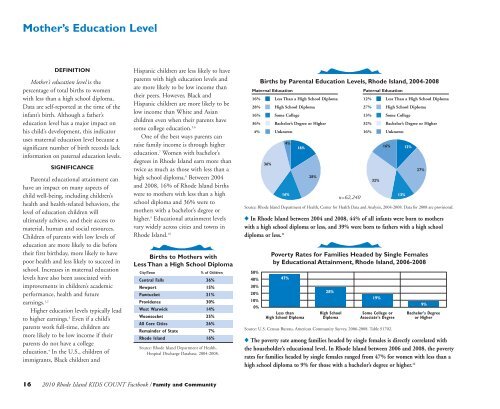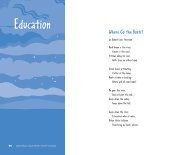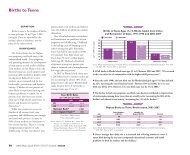2010 Rhode Island Kids Count Factbook
2010 Rhode Island Kids Count Factbook
2010 Rhode Island Kids Count Factbook
Create successful ePaper yourself
Turn your PDF publications into a flip-book with our unique Google optimized e-Paper software.
Mother’s Education Level<br />
DEFINITION<br />
Mother’s education level is the<br />
percentage of total births to women<br />
with less than a high school diploma.<br />
Data are self-reported at the time of the<br />
infant’s birth. Although a father’s<br />
education level has a major impact on<br />
his child’s development, this indicator<br />
uses maternal education level because a<br />
significant number of birth records lack<br />
information on paternal education levels.<br />
SIGNIFICANCE<br />
Parental educational attainment can<br />
have an impact on many aspects of<br />
child well-being, including children’s<br />
health and health-related behaviors, the<br />
level of education children will<br />
ultimately achieve, and their access to<br />
material, human and social resources.<br />
Children of parents with low levels of<br />
education are more likely to die before<br />
their first birthday, more likely to have<br />
poor health and less likely to succeed in<br />
school. Increases in maternal education<br />
levels have also been associated with<br />
improvements in children’s academic<br />
performance, health and future<br />
earnings. 1,2<br />
Higher education levels typically lead<br />
to higher earnings. 3 Even if a child’s<br />
parents work full-time, children are<br />
more likely to be low income if their<br />
parents do not have a college<br />
education. 4 In the U.S., children of<br />
immigrants, Black children and<br />
Hispanic children are less likely to have<br />
parents with high education levels and<br />
are more likely to be low income than<br />
their peers. However, Black and<br />
Hispanic children are more likely to be<br />
low income than White and Asian<br />
children even when their parents have<br />
some college education. 5,6<br />
One of the best ways parents can<br />
raise family income is through higher<br />
education. 7 Women with bachelor’s<br />
degrees in <strong>Rhode</strong> <strong>Island</strong> earn more than<br />
twice as much as those with less than a<br />
high school diploma. 8 Between 2004<br />
and 2008, 16% of <strong>Rhode</strong> <strong>Island</strong> births<br />
were to mothers with less than a high<br />
school diploma and 36% were to<br />
mothers with a bachelor’s degree or<br />
higher. 9 Educational attainment levels<br />
vary widely across cities and towns in<br />
<strong>Rhode</strong> <strong>Island</strong>. 10<br />
Births to Mothers with<br />
Less Than a High School Diploma<br />
City/Town<br />
% of Children<br />
Central Falls 36%<br />
Newport 15%<br />
Pawtucket 21%<br />
Providence 30%<br />
West Warwick 14%<br />
Woonsocket 25%<br />
All Core Cities 26%<br />
Remainder of State 7%<br />
<strong>Rhode</strong> <strong>Island</strong> 16%<br />
Source: <strong>Rhode</strong> <strong>Island</strong> Department of Health,<br />
Hospital Discharge Database, 2004-2008.<br />
Maternal Education<br />
16% Less Than a High School Diploma<br />
28% High School Diploma<br />
16% Some College<br />
36% Bachelor’s Degree or Higher<br />
4% Unknown<br />
70<br />
60<br />
50<br />
40<br />
30<br />
Births by Parental Education Levels, <strong>Rhode</strong> <strong>Island</strong>, 2004-2008<br />
36%<br />
4%<br />
16%<br />
16%<br />
28%<br />
n=62,240<br />
Paternal Education<br />
Poverty Rates for Families Headed by Single Females<br />
by Educational Attainment, <strong>Rhode</strong> <strong>Island</strong>, 2006-2008<br />
Source: U.S. Census Bureau, American Community Survey, 2006-2008. Table S1702.<br />
12% Less Than a High School Diploma<br />
27% High School Diploma<br />
13% Some College<br />
32% Bachelor’s Degree or Higher<br />
16% Unknown<br />
Source: 20 <strong>Rhode</strong> <strong>Island</strong> Department of Health, Center for Health Data and Analysis, 2004-2008. Data for 2008 are provisional.<br />
◆ In 10 <strong>Rhode</strong> <strong>Island</strong> between 2004 and 2008, 44% of all infants were born to mothers<br />
with a 0 high school diploma or less, and 39% were born to fathers with a high school<br />
diploma or less. 11<br />
50%<br />
40%<br />
30%<br />
20%<br />
10%<br />
0%<br />
47%<br />
Less than<br />
High School Diploma<br />
28%<br />
High School<br />
Diploma<br />
◆ The poverty rate among families headed by single females is directly correlated with<br />
the householder’s educational level. In <strong>Rhode</strong> <strong>Island</strong> between 2006 and 2008, the poverty<br />
rates for families headed by single females ranged from 47% for women with less than a<br />
high school diploma to 9% for those with a bachelor’s degree or higher. 12<br />
32%<br />
19%<br />
16%<br />
Some College or<br />
Associate’s Degree<br />
13%<br />
12%<br />
27%<br />
9%<br />
Bachelor’s Degree<br />
or Higher<br />
16 <strong>2010</strong> <strong>Rhode</strong> <strong>Island</strong> KIDS COUNT <strong>Factbook</strong> / Family and Community






